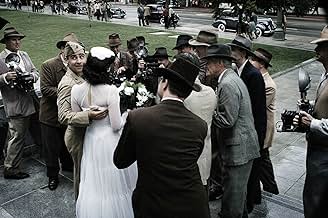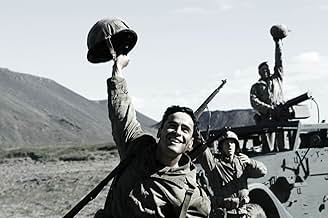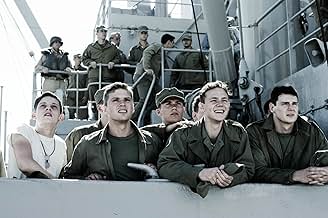Las historias de vida de los seis hombres que izaron la bandera en la batalla de Iwo Jima, un punto de inflexión en la Segunda Guerra Mundial.Las historias de vida de los seis hombres que izaron la bandera en la batalla de Iwo Jima, un punto de inflexión en la Segunda Guerra Mundial.Las historias de vida de los seis hombres que izaron la bandera en la batalla de Iwo Jima, un punto de inflexión en la Segunda Guerra Mundial.
- Dirección
- Guionistas
- Elenco
- Nominado a 2 premios Óscar
- 16 premios ganados y 28 nominaciones en total
Opiniones destacadas
For generations we have been sons of war, and our sons will be fathers of sons of war. Will it end? Perhaps not. Will there be stories like this one told in film or whatever media is next for all generations yet to come, just as there has been for all past? It's a very sad testament to the human condition, but I'll be paying my respect the next time I am in DC with a better understanding of the statue in question.
Based on the true (and relatively unknown) story of six regular soldiers that raised the flag atop the isle of Iwo Jima and whose picture of the effort became synonymous with an impending victory of the war, Flags of our Fathers will be one of the most talked about films of 2006.
Flags of our Fathers follows the lives of three surviving members who raised the flag in 1945 atop Mount Suribachi and how the government used these three individuals and the media in an effort to spark interest in selling war bonds to the American public.
Ryan Phillippe, Jesse Bradford and Adam Beach play John "Doc" Bradley, Rene Gagnon and Ira Hayes respectively. These three individuals were partly responsible for the second American flag raising on that graced newspapers and magazine covers all over the world.
If you caught it, I did write the 'second American flag raising'. A fact that it seemed not one of us in the packed pre-screening knew before the films closing credits. Six soldiers on the 5th day of the island's invasion planted the flag of infamy just seconds after the first flag was that was erected was taken down. As the picture made its circles in every American media outlet available, Bradley, Gagnon and Hayes were quickly sent packing back to the United States to be used in a cross country marketing campaign to drum up support for the troops spread out over Europe and Asia.
Not one of them believing they were true heroes, the three are persuaded to separate their reluctance from the necessity to boost morale with the American public and ask for funds to continue with the necessary production of tanks, grenades, guns and armor. The film then switches between their tours of sporting arenas and speaking engagements and flashbacks back to the horrors of the taking of the island in full vivid detail.
Flags of our Fathers is an important film, but unfortunately, not a stellar one. The battle scenes are very well done and show the chaotic atmosphere and pace that follows a ground war, but it's the relationship and the manipulation of public interest as used by the media that the movie hits home. In a time where America is fighting two separate wars in Afghanistan and Iraq with veterans of Vietnam still being paraded on CNN every evening news to discuss comparisons, Flags of our Fathers is important in that it shows how a single picture or event can change an entire opinion over an effort that will cost young men and women their lives.
But where Eastwood fails is in his attempt to drum up any emotional attachment to the three characters. Haggis does his Crash best to have us 'tisk' at the consistent barrage of racial epithets thrown towards Indian descent Ira Hayes, but Eastwood fails to weave this sympathy and the sympathy for those left behind on the beach into an emotional punch that will carry us to the voting polls in the awards season.
The biggest disappointment with Flags of our Fathers comes with the expectation that the three major players in the production bring to the table. Eastwood in particular has stemmed together three recent films The Forgiven, Mystic River and Million Dollar Baby that each dealt with a person of persons dealing with the emotional weight of violence that they were witness. The heavy handedness of Flags of our Fathers should be right up his wheelhouse. Add the brilliant writing experience and resume of Haggis and the movie should have been celluloid gold. Instead, we deal with waving veterans, moments of tenderness between the soldiers and the families of the dead they fought beside and the emotional burden of the horrors that surrounded them in combat without any tear tugging or tissue pulling on behalf of the experiencing movie watcher.
Flags of our Fathers was shot back-to-back with Letters from Iwo Jima which will shows the Japanese perspective of the battle and is scheduled for release in February 2007. While watching Flags of our Fathers, there are a few scenes that you can imagine being in the next years release and maybe that is where Eastwood and the gang lost their focus.
So why does Flags of our Fathers still get 3 ½ stars even though the comments seem so negative? Well, it is because what the film does right, it does extremely well. During the battle scenes you are transported to Iwo Jima and the chaos of the situation can be felt in how you inch towards the edge of your seats. The acting too is better than average, especially from Phillippe who might find himself along side wife Reese Witherspoon as an awards nominee come Christmas. Couple these pluses with the importance of revealing a true and important story to the mass audiences and the obvious comparisons with American war efforts at the time of print, and you have a film that will undoubtedly become one of Eastwoods most talked about films. Even if it wasn't one of his best.
The war sequences are skillfully executed. It reminds me of the early sequences of 'Saving Private Ryan' as its shot with washed out colours and the scenes are just as visceral and hard-hitting. They are extremely effective as are the scenes where the three survivors are being paraded by officers in order to sell military bonds. The real truth is ignored, the illusion of a photo is confirmed as truth, the three soldiers are burning in the inside while obliged to parade themselves and then they are left with nothing, just memories of the war. Eastwood has also briefly but effectively tackled the racism theme. Even the label of a hero was not enough for Hayes to get a drink at a bar.
Haggis's writing is solid. War isn't glorified and the aftereffects are shown with subtlety rather than blatant preaching. The editing is tight as the movie flows at a smooth pace. It starts off with the war sequences and then follows the three surviving flag-raisers revisiting the war in flashbacks. Eastwood's soundtrack is intense and gives voice to the unspoken words. All the performances are good but it is Jesse Bradford, Adam Beach and Ryan Phillipe who stand out as the three survivors, particularly Phillipe who is restrained.
'Flags of Our Fathers' an important side of the war that almost vanished into oblivion but thanks to Eastwood and his team, many people today will know about it.
That one picture is said to be the most reproduced picture in the history of photography.
I toured Iwo Jima in 2000 with my father, a private in the 5th Marine Division, who, along with the flag raisers, landed on Iwo Jima on February 19, 1945 -- the opening day of what would be the costliest battle in the history of the U.S. Marine Corps.
I can't say enough good things about the realism of Clint Eastwood's "Flags of our Fathers." Visually, the movie made me think that I was back on Iwo Jima, and emotionally, I felt like I was witnessing what I had been told by Iwo survivors and what I had read in Richard E. Overton's "God Isn't Here: A Young American's Entry into World War II and His Participation in the Battle for Iwo Jima."
James Bradley's book "Flags of our Fathers," is wonderful, and this movie of the same name is very faithful to his book.
But, the editing of the movie takes the viewer through so many flash-backs and flash-forwards that it's hard to keep things straight -- even if you have read the book!
The movie opens with Harve Presnel (I think it was Harve) playing the role of what I thought was a narrator. Later, it looks like he's just one of many people that James Bradley interviewed for his book.
I was expecting some corny things in the movie, like seeing the flag raising picture taking up the full screen in the theater while the Marine Corps Hymn played. That didn't happen. After I heard what I thought was a narrator, I thought that anyone who didn't know what was going on in the movie would probably be kept informed of the not-so-obvious things . . . like it was Howlin' Mad Smith who was demanding, and not getting, additional bombardment of the island; like it was Secretary of the Navy, James Forrestal, who told Howlin' Mad Smith that "...the raising of that flag on Suribachi means a Marine Corps for the next five hundred years." These events were in the movie, but the characters were neither introduced by name in the movie, nor were they described by "the narrator," who seemed to come and go at odd times.
Ira Hayes is a tragic character. It's obvious that Hollywood likes tragic characters just because of all of the attention that he gets in this movie, and because Tony Curtis made a movie about Ira Hayes back in 1961. The actor who plays Ira in this movie is great!
Stephen Spielberg and Clint Eastwood obviously had to tap dance around an "Elephant in the Room" when it came to showing what happened to John Bradley's friend on Iwo Jima. If you've read the book, you know what happened. The movie does a masterful job of bringing the subject up, but not bringing it up in a manner that would offend the squeamish, or, for that matter, bringing it up in a way that would make it impossible to show the movie to a Japanese audience.
¿Sabías que…?
- TriviaThe story about the flag raising being posed was true. It was started, ironically, by Joe Rosenthal. He did not know he had taken the famous photograph until he returned to the States. He did, however, take a second photograph of the five Marines and one Navy Corpsman gathered around the flag. When people asked if he had posed the photograph, he, thinking they were referring to the second photograph said "Of course". It was only after seeing the first photograph that he realized they were referring to that photograph and not the second one.
- ErroresIn explaining the importance of a successful bond drive, the treasury representative says that the fuel dumps are empty and "our Arab friends only take bullion." At the time of World War II, America was essentially self sufficient in oil production and not dependent on Arab oil. While oil was discovered in some Arab countries before the war, it was not extensively developed until after the war.
- Citas
[last lines]
James Bradley: I finally came to the conclusion that he maybe he was right. Maybe there's no such thing as heroes. Maybe there are just people like my dad. I finally came to understand why they were so uncomfortable being called heroes. Heroes are something we create, something we need. It's a way for us to understand what's almost incomprehensible, how people could sacrifice so much for us, but for my dad and these men, the risks they took, the wounds they suffered, they did that for their buddies. They may have fought for their country but they died for their friends. For the man in front, for the man beside him, and if we wish to truly honor these men we should remember them the way they really were, the way my dad remembered them.
- Créditos curiososThere is an additional short sequence after the credits have ended.
- Bandas sonorasKnock Knock
Written and Performed by Kyle Eastwood, Michael Stevens, Andrew McCormack and Graeme Flowers
Selecciones populares
Detalles
- Fecha de lanzamiento
- País de origen
- Sitios oficiales
- Idioma
- También se conoce como
- Flags of Our Fathers
- Locaciones de filmación
- Productoras
- Ver más créditos de la compañía en IMDbPro
Taquilla
- Presupuesto
- USD 90,000,000 (estimado)
- Total en EE. UU. y Canadá
- USD 33,602,376
- Fin de semana de estreno en EE. UU. y Canadá
- USD 10,245,190
- 22 oct 2006
- Total a nivel mundial
- USD 65,900,249
- Tiempo de ejecución2 horas 15 minutos
- Color
- Mezcla de sonido
- Relación de aspecto
- 2.39 : 1
Contribuir a esta página











































